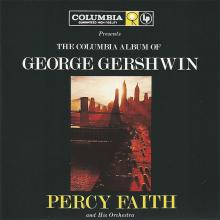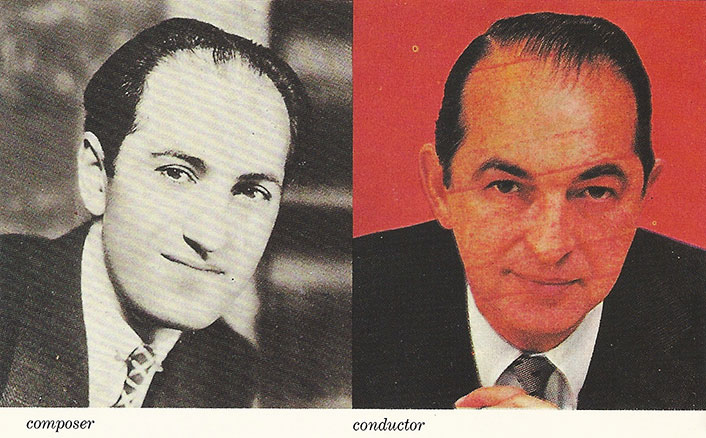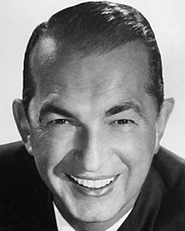Columbia Album Of George Gershwin
Columbia Album Of George Gershwin
Record 1
-
Fascinatin' Rhythm
-
Medley: A Foggy Day / Soon
-
Clap Yo' Hands
-
Embraceable You
-
Mine
-
Somebody Loves Me
-
I Got Plenty O' Nuttin'
-
Summertime
-
Bess, You Is My Woman Now
-
My Man's Gone Now
-
Nice Work If You Can Get It
-
For You, For Me, For Evermore
-
Liza (All The Clouds'll Roll Away)
Record 2
-
's Wonderful
-
Love Is Here To Stay
-
They Can't Take That Away From Me
-
The Man I Love
-
Love Walked In
-
Oh, Lady Be Good
-
Preludes #2 & 3
-
Maybe
-
Someone To Watch Over Me
-
They All Laughed
-
Bidin' My Time
-
I Got Rhythm
Availability
Lp (mono): Columbia C2L-1 (USA, 2-Lp set containing CL 1064 & CL 1065)
CD: Sony Music Special Products A2K 47862 (2-CD set) (USA)
Liner notes
The music of George Gershwin played in this collection by Percy Faith and His Orchestra is discussed here chronologically, to help place it in perspective.
Somebody Loves Me
This song was unforgettably interpreted by Winnie Lightner in the Scandals of 1924. Its appeal is primarily melodic, for in this song Gershwin tapped the rich, full-blooded lyricism that henceforth would identify his best love songs. Gershwin’s way of suddenly interpolating a flatted third in the melody here personalized his writing. The nebulous harmony was also a part of the song’s charm. “Somebody Loves Me” was one of Gershwin’s greatest hits after “Swanee.”
Oh, Lady Be Good and Fascinatin’ Rhythm
Lady Be Good was Gershwin’s first major musical-comedy success. It opened on December 1, 1924, the first musical produced by the new team of Aarons and Freedley, who were to be associated with so many Gershwin musicals. Fred and Adele Astaire were starred. Cast as a brother-and-sister dancing act who had come upon unhappy days.
Gershwin’s music was the principal attraction of this gay musical. Never before had he brought such a wealth of original invention to his stage music. The irresistible appeal the repeated triplets in the title song, the kinesthetic effect of the changing meters in “Fascinatin’ Rhythm”—all this represented a new sophistication in popular music.
The Man I Love
The best song Gershwin wrote for Lady Be Good was not in the show when it opened in New York. It has since become one of the Gershwin song classics, and the one song he often considered his greatest. But before it finally achieved recognition it had an eventful history. The chorus as it is known today originated as the verse for another song; but Gershwin soon realized that the individual melody consisted of a six-note blues progression that reappeared through with cumulative effect, achieving poignancy through the contrapuntal background of a descending chromatic scale. In rewriting his song, Gershwin now used the verse as the chorus, and prefaced it with a simple but appealing introductory tune.
“The Man I Love” was sung by Adele Astaire in the opening scene of the Philadelphia tryout of Lady Be Good. In that setting the song missed aim completely; it was too static. Vinton Freedley insisted that it be dropped from the show, and Gershwin consented. In 1927, Gershwin removed the song from his shelf and incorporated it into the score he was then writing for Strike Up the Band (first version). Once again it was tried out of town, was found wanting, and was deleted.
But the song found admirers. One of them was Otto H. Kahn, to whom Gershwin played it when he planned using it for Lady Be Good. Kahn liked the song so much that he decided to invest $10,000 in the musical. Another admirer was Lady Louis Mountbatten, to whom Gershwin presented an autographed copy in New York. When she returned to London, Lady Mountbatten arranged for the Berkeley Square Orchestra to introduce the song there. It became such a success that—though no printed copies were available in England—it was picked up by many other jazz groups in Paris, where it also caught on. American visitors to London and Paris heard the song and, returning home, asked for it. Then singers and orchestras took it up until its acceptance in this country became complete.
Gershwin has explained that the reason it took so long for the song to be appreciated is that the melody of the chorus, with its chromatic pitfalls, was not easy to catch; also, when caught, it was not easy to sing or whistle or hum without a piano accompaniment.
Preludes Two and Three
On December 4, 1926, at the Hotel Roosevelt in New York, Marguerite d’Alvarez, the operatic contralto, gave a serious song recital that included French and Spanish art songs. Gershwin participated, not only by accompanying her in his songs, but also by appearing as piano soloist. On this occasion, he gave the world premiere of his Preludes for the piano.
The second, in C-sharp minor (Andante con moto e poco rubato) is the most famous of the set: a poignant three-part blues melody set against an exciting harmony that grows richer as the melody unfolds. Rhythm once again predominates in the third prelude, in B-flat major (Allegretto ben ritmatto e deciso), an uninhibited outburst of joyous feeling.
Clap Yo’ Hands, Maybe, and Someone to Watch over Me
Oh, Kay, in 1926, was the first American musical comedy starring Gertrude Lawrence, who had made her Broadway debut in 1924 in the Charlot’s Revue imported from London. When Aarons and Freedley discussed with her the possibility of coming to New York in a new musical, she was considering a similar offer from Ziegfeld. The information that George Gershwin would write the music was the deciding factor in her acceptance of the Aarons and Freedley contract.
The Gershwin score was a rich cache of treasures, “a marvel of its kind,” as Percy Hammond Reported. To no other musical production up to this time had he been so lavish in his gifts. There was “Someone to Watch over Me,” in his most soaring and beguiling lyric vein touched with the glow of Gertrude Lawrence’s charm, “Clap Yo’ Hands,” with its fascinating rhythms, and “Maybe.”
‘S Wonderful
In 1927, Aarons and Freedley built a new theater for their productions, the Alvin on West 52nd Street. It was a house that Gershwin had helped build with the profits from Lady Be Good, Tip Toes and Oh, Kay. What, then was more appropriate than that it should be opened on November 22 with a new Gershwin musical? The musical was Funny Face, in which Fred and Adele Astaire made their first welcome return in a Gershwin musical since Lady Be Good. Victor Moore was also in the cast, appearing as a helpless, hapless thug who gets involved in all sorts of difficulties while trying to steal a string of pearls. “’S Wonderful” was the hit of the show.
Liza
“Liza” was a particular favorite of Gershwin’s. He continually played it for friends, frequently with improvised variations. It appeared in Show Girl, a lavish Ziegfeld production, in 1929. Ruby Keeler sang and danced to its tantalizing rhythms, as her husband Al Jolson ran up and down the aisles singing the refrain to his wife—for several nights an unscheduled, unexpected and unpaid-for attraction.
Soon
With Strike Up the Band, in 1929, a new kind of musical came to Times Square. This was no longer just a spectacular for the eye and an opiate for the senses—as had been the case with so many earlier Gershwin musicals—but a bitter satire on war, enlisting all the resources of good theatre….It was first launched in 1927…and was abandoned. In 1929, the authors returned to the play….It brought new dimensions to musical comedy by being one of the first with a pronounced political consciousness.
The Gershwin score—which was published in its entirety—is not only rich in details. Individual songs stand out prominently, “Soon” is one of Gershwin’s most beautiful ballads, unforgettable for its purple mood.
Embraceable You, Bidin’ My Time, I Got Rhythm
Girl Crazy, one of Gershwin’s greatest musical-comedy successes, began a long run at the Alvin Theatre on October 14, 1930. The book, by Bolton and MacGowan, was no better—and no worse—than earlier ones for which Gershwin supplied the music….One of the things that made Girl Crazy as good as it was—“a never-ending bubbling of pure joyousness,” as one New York critic described it—was the casting. Ginger Rogers, fresh from her first screen triumph in Young Man of Manhattan, here made her bow on the Broadway stage. Willie Howard brought his accent and uninhibited comedy to the part of Gieber Goldfarb. Allen Kearns, veteran of many Gershwin musicals, was cast in the male lead. Each of these gave a performance calculated to steal the limelight. But the limelight belonged not to any of them, but to a young and then still unknown lady whose personality swept through the theater like a tropical cyclone, and whose large, brassy voice struck the consciousness of the listeners like a sledge hammer. She was Ethel Merman, in her first appearance in musical comedy….In “I Got Rhythm” she threw her voice across the footlights the way Louis Armstrong does the tones of a trumpet. When, in the second chorus, she held a high C for sixteen bars, while the orchestra continued with the melody, the theater was hers: not only the Alvin theatre, but the musical theater as well. “I Got Rhythm” is remarkable in its chorus not only for the agility of the changing rhythms, but also for the unusual melody made up of a rising and falling five-note phrase in the pentatonic scale.
“Embraceable You,” the hit song of the production, belongs to the half dozen or so of Gershwin song classics in which his melodic writing is most expressive.
Mine
In 1933, many of those who had helped make the Pulitzer Prize-winning “Of Thee I Sing” the historic occasion it was in the theater, joined forces for a sequel entitled Let ‘Em Eat Cake….There was much that was bright and witty and stinging; but the play as a whole did not quite jell. The critics and audiences rejected the play and it failed to reach its hundredth performance on Broadway.
On the positive side was one of Gershwin’s important songs, “Mine.” This was a pioneer attempt to use a vocal counterpoint for the main melody (a practice subsequently employed so effectively by Frank Loesser in “Baby, It’s Cold Outside” and Irving Berlin in “You’re Just in Love”). The vocal counterpoint consists in an aside by the chorus which carries overtones of Gilbert and Sullivan.
I Got Plenty o’ Nuttin’, Summertime, Bess, you Is My Woman Now, My Man’s Gone Now
The writing of Porgy and Bess occupied Gershwin for about twenty months. Most of the actual composition was done in about eleven months and completed in mid-April 1935. While some of the orchestration for the first act had been done in September 1934, that task consumed about eight months in 1935. Then it was completed: seven hundred neat and compact pages of written music (560 pages of the published vocal score), which if performed as written would require four and a half hours. During rehearsals, cuts had to be made in order to compress the opera within the prescribed limits of a normal evening at the theater.
Porgy and Bess opened at the Colonial Theatre in Boston on September 30, 1935. The audience began early to demonstrate its enthusiasm, and by the time the opera ended the ovation reached such proportions that the shouts and cries lasted over fifteen minutes….Two weeks later, on the evening of October 10, Porgy and Bess came to New York, to the Alvin Theatre….
They Can’t Take That Away from Me, They All Laughed, A Foggy Day, Nice Work if You Can Get it, Love Is Here to Stay, Love Walked in
After 1935, and up to the time of his death, Gershwin worked exclusively for motion pictures. His first film, during this period, was a Fred Astaire-Ginger Rogers musical, Shall We Dance?, described by The New York Times as “One of the best things the screen’s premiere dance team has done, a zestful, prancing, sophisticated musical.” Gershwin’s score was a gold mine, and two of the treasures were the deft and suave “They Can’t Take That Away from Me” and “They All Laughed.”
One chore completed, Gershwin went to work for another screen musical. The star once again was Fred Astaire, but this time he was paired with a new dancing partner, Joan Fontaine. This film, A Damsel in Distress, would not have been “half so good without the splendid Gershwin melodies,” reported Howard Barnes in the New York Herald Tribune. The best of these melodies were “A Foggy Day” and “Nice Work if You Can Get It.”
Gershwin’s last score was for the Goldwyn Follies, for which he did not live to complete. He was able to write only five numbers for that production, and for some of those Vernon Duke had to provided the verses. Since two of these Gershwin songs are among his most beautiful—“Love Is Here to Stay” and “Love Walked in”—it is apparent that even in his last troublesome months there was no creative disintegration, and that when he died so prematurely he was still at the height of his melodic powers.
For You, for Me, for Evermore
Manuscripts left behind by Gershwin were explored for possibilities, and in 1947 a new motion picture, The Shocking Miss Pilgrim with Betty Grable, offered a “new” and posthumous score, with lyrics, by the irreplaceable Ira. Several of the songs became popular, the most lasting of them being “For You, for Me, for Evermore.”


